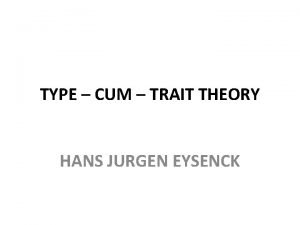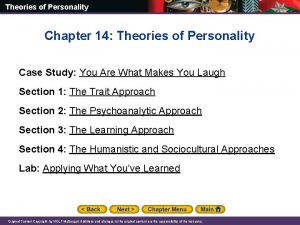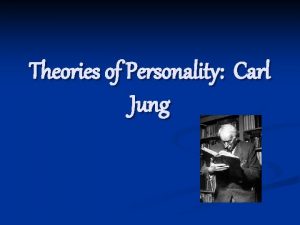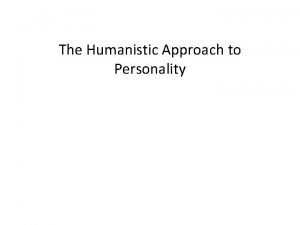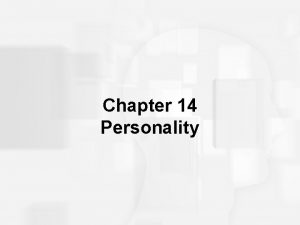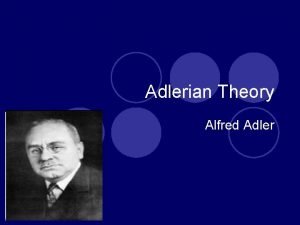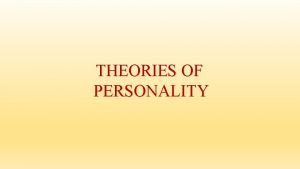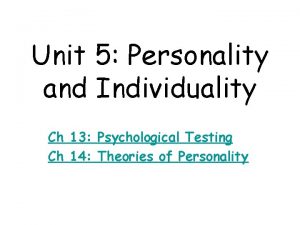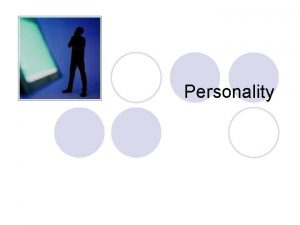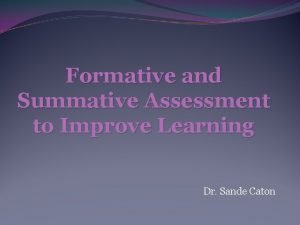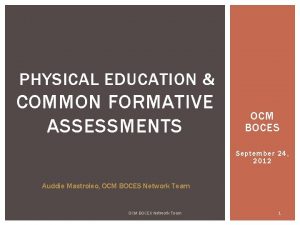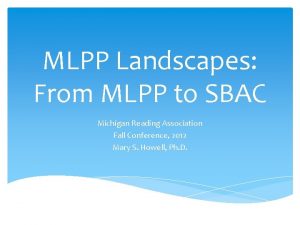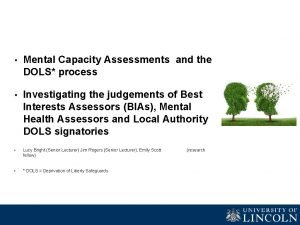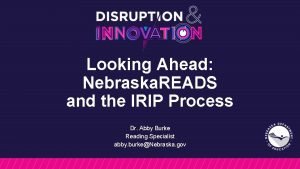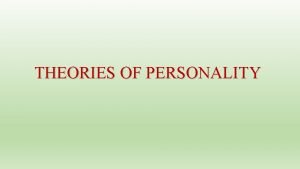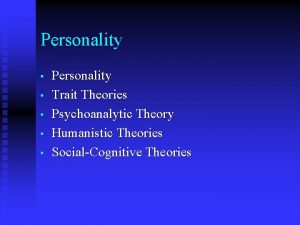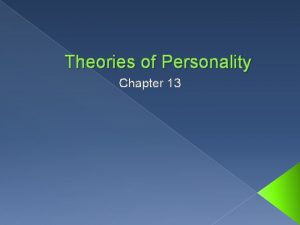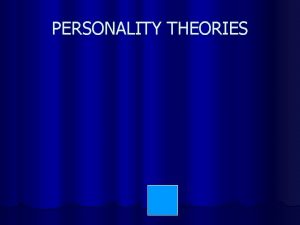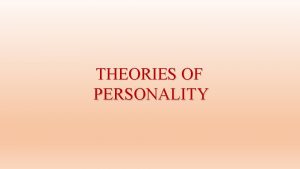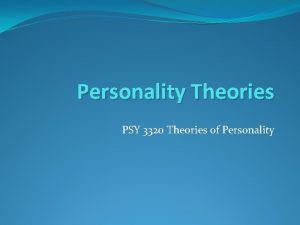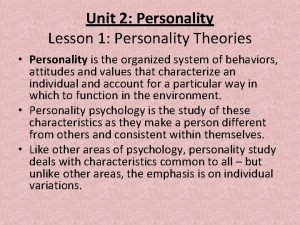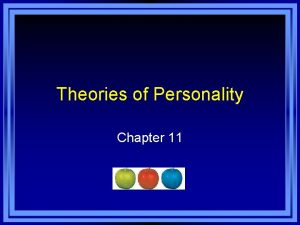PERSONALITY A LOOK AT PERSONALITY THEORIES AND ASSESSMENTS






























- Slides: 30

PERSONALITY A LOOK AT PERSONALITY THEORIES AND ASSESSMENTS

� What is Personality? � People differ from each other in meaningful ways � People seem to show some consistency in behavior � Personality is defined as distinctive and relatively enduring ways of thinking, feeling, and acting PERSONALITY

�Personality refers to a person’s unique and relatively stable pattern of thoughts, feelings, and actions � Personality is an interaction between biology and environment �Genetic studies suggest heritability of personality �Other studies suggest learned components of personality PERSONALITY DEFINED

� � � � Traits are relatively stable and consistent personal characteristics Trait personality theories suggest that a person can be described on the basis of some number of personality traits Allport identified some 4, 500 traits Cattel used factor analysis to identify 30 -35 basic traits Eysenck argued there are 3 distinct traits in personality • Extraversion/introversion • Neuroticism • Psychotocism PERSONALITY TRAITS

Openness (original and open to new ideas vs. conventional and narrow in interests) � Conscientiousness (responsible and organized vs. irresponsible and careless) � � Extroversion (sociable and talkative vs. withdrawn and quiet) Agreeableness (trusting and good-natured vs. suspicious and ruthless) � Neuroticism (emotionally unstable and moody vs. emotionally stable and easygoing) � Trait Theorists: The Five-Factor Model

Write a story about the first thing that comes to mind while looking at this picture. TAT Personality Tests (Thematic Apperception Test)

� Psychoanalytic theory, as devised by Freud, attempts to explain personality on the basis of unconscious mental forces � Levels of consciousness: We are unaware of some aspects of our mental states � Freud argued that personality is made up of multiple structures, some of which are unconscious � Freud argued that as we have impulses that cause us anxiety; our personality develops defense mechanisms to protect against anxiety PSYCHOANALYTIC THEORY

Levels of Consciousness – Conscious What we’re aware of – Preconscious Memories etc. that can be recalled – Unconscious Wishes, feelings, impulses that lie beyond awareness Structures of Personality – Id Operates according to the “pleasure principle” (crying infant) – Ego Operates according to the “reality” principle, meet the needs of the id, while considering reality – Superego Contains values and ideals, right and wrong FREUDIAN THEORY

Conscious – Ego – Some Superego Preconscious – Same available if needed Unconscious – Id – Some Superego – Some Ego PERSONALITY: FREUD

�Freud’s work lays the groundwork for all subsequent personality theories. �It is the most comprehensive theory—he tries to explain everything humans are and do. Why study Freud?

�Development is driven by biology-we inherit drives and instincts. �Early experiences engender adult psychology-the events of the first 5 -6 years determine psychological development. �Early social life is important-how mom and dad responded to our desire toward pleasure. ASSUMPTIONS IN FREUD’S WORK

�ALL PLEASURE IS ULTIMATELY SEXUAL PLEASURE!!! �From birth, infants seek sexual pleasure— Freud said breastfeeding was a sexual act. ASSUMPTIONS IN FREUD’S WORK

� Psychosexual stages: Freudian idea of five developmental periods key to personality development *Personality is mostly established by the age of five. *Early experiences play a large role in personality development and continue to influence behavior later in life. *Said that personality develops through a series of childhood stages during which the pleasureseeking energies of the ID become focused on certain erogenous areas. This energy (the libido) is the driving force behind behavior.

�If the stages are completed successfully, the result is a healthy personality. �If certain issues are not resolved at the appropriate stage, a fixation can occur. �Until this conflict is resolved, the individual will remain “stuck” in this stage. PSYCHOSEXUAL DEVELOPMENT

�Freud said that psychosocial development is usually halted in one of the first three stages when a child becomes fixated (stuck) in one of the developmental conflicts. �We become fixated when we receive too little or too much pleasure in any given stage. �So, when fixated people encounter stress in their adult lives, they regress to that stage. Fixation

�Birth �Child to 18 months is focused on oral pleasures such as rooting and sucking. �The mouth is vital for eating and the infant derives pleasure from the oral stimulation through gratifying activities such as tasting and sucking. �Too much or too little gratification can result in an oral fixation or oral personality— preoccupied with oral activities such as smoking, drinking, eating, biting nails. THE ORAL STAGE

� 18 months to 3 years � Major focus is on eliminating and retaining feces. � Through society’s pressure, the child has to learn to control anal stimulation—toilet training! � Developing this control leads to a sense of accomplishment and pride. � *Freud says it depends on how parents teach-if too lenient and an anal-expulsive personality can develop-person is destructive and disorganized. � If too strict, person develops an anal-retentive personality and is obsessed with cleanliness and order. THE ANAL STAGE

�Ages 3 to 6 �Pleasure zone switches to the �Oedipus Complex: According genitals. to Freud, boys develop unconscious sexual desires for their mothers. �Boy then becomes a rival with fathercompetes for mother’s attention. �Wanting to possess the mother and replace the father �Child also fears that he will be punished for this-castration anxiety. THE PHALLIC STAGE

�GIRLS- later it was decided that they went thru same thing—called Electra Complex. �Freud disagreed with this and said instead that girls experience penis envy. �According to Freud, out of fear of castration and due to the strong competition of father— boy develops masculine characteristics, and represses his sexual feelings. �Fixation in this stage: could result in sexual deviancies and weak or confused sexual identity. THE PHALLIC STAGE

�Age six to puberty �Libido interests are suppressed. �Development of ego and superego contribute to this calm. �Begins around time that kids start school and become concerned with peer relationships, hobbies and other interests. �Important to development of social and communication skills and self-confidence. LATENCY STAGE

�Puberty on…. �Final stage of psychosexual development. �Individual develops a strong sexual interest in the opposite sex. �Interests in the welfare of others grows during the stage. �If the other stages have been successfully completed, person should be wellbalanced, warm, and caring. GENITAL STAGE

�Freud believed all children pass through five psychosexual stages. At each stage the id’s pleasure seeking energies focus on specific pleasure areas of the body (erogenous zones).

� Difficult to test, but the evidence that has been gathered is not favorable. � The crucial events (e. g. , how the libido is used) are unobservable, and there are no good means to measure them. � There is an awfully long time between the occurrence of the causal stimulus and its presumed effect; relationships between early events and later traits tend to be weak and inconsistent. � This theory of development was conceived without studying children; rather, it was developed from patients' recollections, dreams and free associations. EVALUATING FREUD’S THEORY

�Projective Tests – Used to assess personality (e. g. , Rorschach or TAT tests) – How? Provides ambiguous stimuli and subject projects his or her motives into the ambiguous stimuli. ASSESSING THE UNCONSCIOUS

Thematic Apperception Test (TAT) -people express their inner motives through the stories they make up about ambiguous scenes Assessing the Unconscious-TAT

Rorschach Inkblot Test – the most widely used projective test – a set of 10 inkblots designed by Hermann Rorschach -used to identify peoples feelings by analyzing their interpretations of the inkblots. ASSESSING THE UNCONSCIOUSRORSCHACH

Example #1

Example #2

Example #3

Example #4
 Look up look down look all around
Look up look down look all around Trait theory hans eysenck
Trait theory hans eysenck Rogers view of personality
Rogers view of personality Carl jung theory of personality
Carl jung theory of personality Carl rogers mbti
Carl rogers mbti Theories of personality quiz
Theories of personality quiz Highly dogmatic consumers
Highly dogmatic consumers Alfred adler theory of personality summary
Alfred adler theory of personality summary Theories of personality
Theories of personality Trait theories of personality _____.
Trait theories of personality _____. L
L Look at the image in activity 1
Look at the image in activity 1 Activity 1 look at the picture
Activity 1 look at the picture Activity 1 a) look at the picture
Activity 1 a) look at the picture General revision of assessments and property classification
General revision of assessments and property classification Formal and informal assessments
Formal and informal assessments Formal and informal test
Formal and informal test Formative summative and diagnostic assessment
Formative summative and diagnostic assessment What is physical fitness test in mapeh
What is physical fitness test in mapeh التحصيلي
التحصيلي Performance assessments examples
Performance assessments examples Premarital tests or assessments
Premarital tests or assessments Formative assessments in physical education
Formative assessments in physical education Design a museum exhibit holistic rubric
Design a museum exhibit holistic rubric Mlpp assessments
Mlpp assessments 6 assessments for dols
6 assessments for dols Nebraska reads approved assessments
Nebraska reads approved assessments Eccentric viewing techniques occupational therapy
Eccentric viewing techniques occupational therapy Elpac proficiency levels
Elpac proficiency levels Cte technical skills assessments.azed.gov/student
Cte technical skills assessments.azed.gov/student Creative arts grade 8 exam papers
Creative arts grade 8 exam papers

